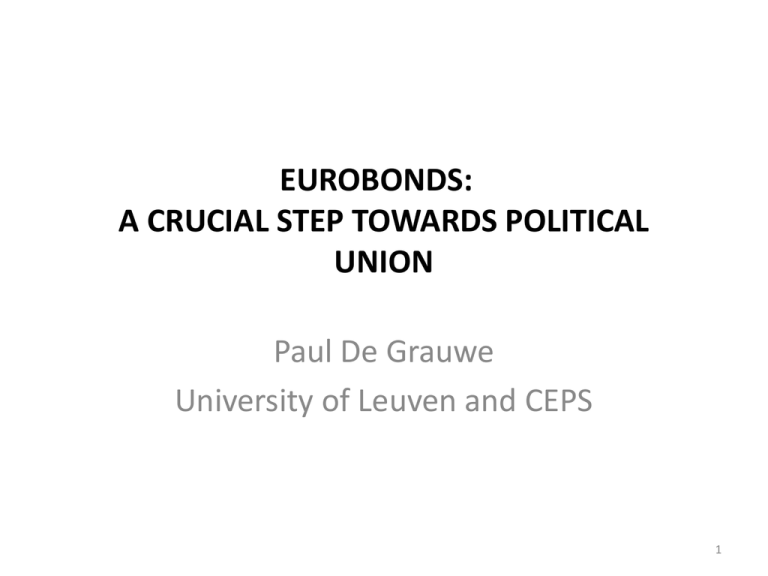Eurobonds: a crucial step towards political union and an engine for
advertisement

EUROBONDS: A CRUCIAL STEP TOWARDS POLITICAL UNION Paul De Grauwe University of Leuven and CEPS 1 Introduction • Euro zone is thrown in a deep and existential crisis. • This crisis has led to an increasing consensus that political union is necessary to preserve euro zone • At the same time, there appears to be little willingness in Europe today to take drastic steps towards a political union. • Thus, if the euro is to be preserved, a strategy of small steps towards more political integration will be necessary. 2 • I will argue that a common Eurobond issue is an important first step towards political union • that can pacify financial markets and bring back financial stability in the euro zone. • In addition, the joint issue of Eurobonds can also be used to provide a boost to economic growth in the euro zone. 3 • I will also draw the attention to a number of objections that have been raised against the issue of joint Eurobonds. • These objections have to be taken seriously. • They have to be dealt within the design of the Eurobonds. 4 The need of Eurobonds: political • The crisis has degenerated into an existential crisis of the euro zone. • Investors now ask themselves the question of whether the euro zone, as we know it today, will survive. • This lack of trust in the future of the euro zone leads to endemic instability. • It has the effect of transforming bad news about one particular country into bad news for other countries, and for the system as a whole. 5 • Crisis has been made worse by the decision of the European Council of October and December to make bondholders pay if future governments ask for financial assistance. • This decision has destabilized the government bond markets in the eurozone and will continue to do so because it makes them vulnerable to self-fulfilling speculative attacks • Very much like the ERM 6 • This vicious circle inherent in the endemic instability must be halted. • This can only happen if the member countries are willing to design a mechanism that will convince the market about the seriousness of their commitments towards the euro zone. • Solemn declarations by leaders of government will not be sufficient. They are seen as “cheap talk”. 7 • A common Eurobond is such a mechanism. • By jointly issuing Eurobonds the participating countries become jointly liable for the debt they have issued together. • This is a very visible and constraining commitment that will convince the market that member countries are serious about the future of the euro. 8 • In addition, market participants will see it as a first step on the road to political union. • This will “pacify” the financial markets because it takes away the existential fears that destabilize them today. • As a result, it will contribute towards restoring stability in the euro zone. 9 Financial need for Eurobonds • By creating a large bond market in the euro zone that can compete with the dollar bond market, it also creates a market with a lot of liquidity. • This will make it attractive for outside investors (e.g. from Asia) in search of diversification. • This also increases attractiveness for AAAcountries in eurozone 10 Objections to Eurobonds • The proposal of issuing common Eurobonds has met stiff resistance in a number of countries. • This resistance is understandable. • A common Eurobond creates a number of serious problems that have to be addressed 11 Moral hazard • Common Eurobond issue contains an implicit insurance for the participating countries. • Since countries are collectively responsible for the joint debt issue, an incentive is created for countries to rely on this implicit insurance and to issue too much debt. • This creates a lot of resistance in the other countries that behave responsibly. • This moral hazard risk should be resolved. 12 Low attractiveness for AAA-countries • What are the benefits for AAA-countries? • By joining a common bond mechanism that will include countries enjoying less favourable credit ratings, countries like German and the Netherlands may actually have to pay a higher interest rate on their debt. 13 The design of common Eurobonds • Should take care of these objections • This can be achieved by working both on the quantities and the pricing of the Eurobonds • A combination of – Blue and red bonds (Bruegel): participation in common eurobond limited to given % of GDP (blue bond; senior); the rest is red bond (junior). – Differential interest rates (De Grauwe and Moesen): countries pay an interest rate related to fiscal position 14 • Such a design minimizes moral hazard risk • Makes it attractive for AAA-countries (they face low average and marginal borrowing cost) • and for lower rated countries (they face relatively low average borrowing costs but high marginal costs). • This design gives the right incentives to low rated countries 15 Optimal Design of eurobond Interest rate Interest rate Low-rating country AAA-country MBC ABC < MBC ABC ABC = MBC 60% Debt ratio 60% Debt ratio ABC = average borrowing cost MBC = marginal borrowing cost 16





